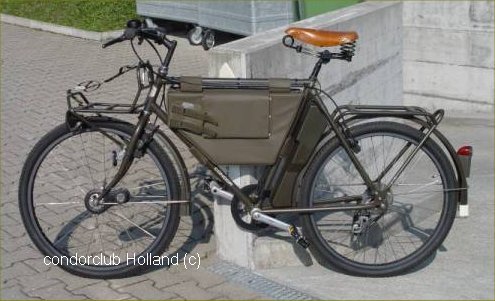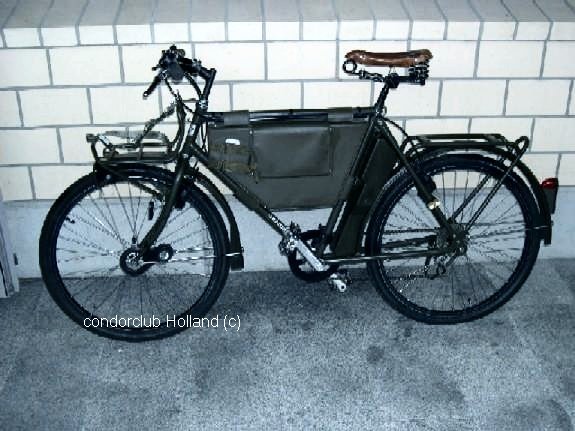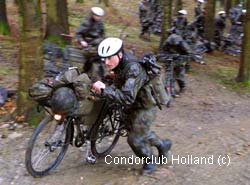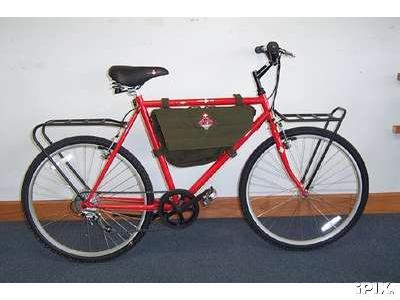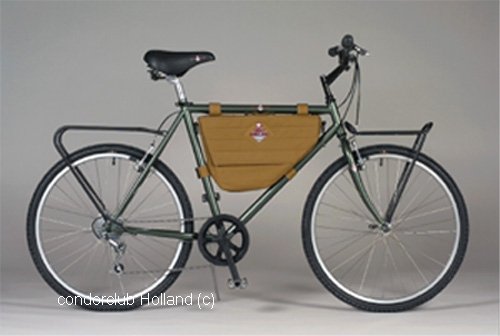|
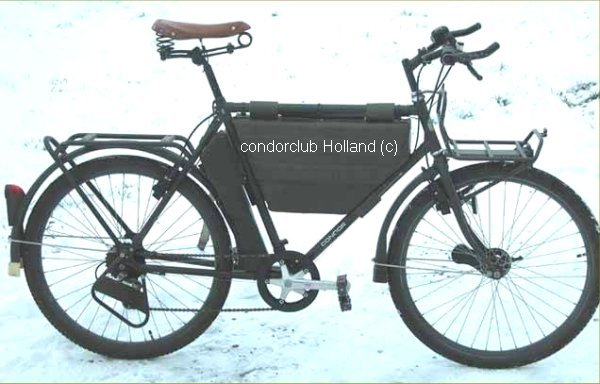 Die
Schweizer Armee soll zu einer schlagkräftigen Hightech-Truppe umfunktioniert
werden. «Folkloristische» Elemente wie die Radfahrertruppen haben darin keinen
Platz mehr. Im Frühling dieses Jahres hiess es für über tausend Velosoldaten zum
letzten Mal «Abtreten!». Die
Schweizer Armee soll zu einer schlagkräftigen Hightech-Truppe umfunktioniert
werden. «Folkloristische» Elemente wie die Radfahrertruppen haben darin keinen
Platz mehr. Im Frühling dieses Jahres hiess es für über tausend Velosoldaten zum
letzten Mal «Abtreten!».
«Stell
dir vor, es ist Krieg, und alle kommen mit dem Velo». Die leichte Abänderung des
populären Brecht-Zitats macht drastisch klar, dass den uniformierten und
bewaffneten Velofahrern jene Ernsthaftigkeit fehlt, auf der jede kriegerische
Abschreckung basiert. Selbst die militärische Sprachregelung, die den Begriff
«Velofahrer» konsequent ächtet und stets durch «Radfahrer» ersetzt, kann den
gewünschten martialischen Eindruck nicht herstellen. Zu diesem Schluss scheint
auch die Schweizer Regierung gekommen zu sein. So verkündete
Verteidigungsminister Samuel Schmid am 27. Februar 2001 offiziell, dass die über
110-jährige Truppengattung im Rahmen der Umstrukturierungen zur Armee XXI
kurzerhand abgeschafft werde. Die Betroffenen selber – die passionierten
Radfahrersoldaten – nahmen den Entscheid eher gelassen entgegen. Der erwartete
grosse Aufschrei blieb aus.
Martin Gubler beispielsweise, Kommandant des letzten Radfahrerregiments der
Schweiz, erklärte im vergangenen Juni gegenüber der «SonntagsZeitung»: «Wir
Radfahrer haben den Entscheid, der schon vor zwei Jahren fiel, mit sportlicher
Haltung akzeptiert.» Da und dort beklagen sich zwar noch Einzelne in den
Gästebüchern der einschlägigen Internetseiten über das schnelle Ende der mobilen
Truppe. So der St. Galler Chris Neff auf der Homepage des Radfahrerregiments 6:
«Meines Erachtens ist es eine Schande, die Radfahrer abzuschaffen. In
Kriegsfällen würden wir sowieso nicht mit dem Rad zum effektiven Einsatz
gelangen. Doch die Ausbildung als Radfahrer garantiert eher, dass die Soldaten
ein körperlich höheres Leistungsniveau erreichen als Fusssoldaten. Ich bin echt
enttäuscht, dass das stolze &Mac220;Aushängeschild&Mac221; der Schweizer Armee
ins Alteisen geworfen wird.»
Doch
in einem Land, wo 1972 über 400’000 BürgerInnen eine Petition für den Erhalt der
Armeekavallerie unterschrieben haben, wo 1995 die Freunde der Armeebrieftauben –
zwar erfolglos – eine «Volksinitiative für eine Schweizer Armee mit Tieren»
lancierten und wo die Bauernlobby mit entsprechendem Druck dafür sorgte, dass es
auch in der modernen Armee XXI Militärpferde-Truppen (den so genannten «Train»)
gibt, ist dieser Widerstand schwach. Fast ein bisschen lendenlahm für eine so
sportliche Truppe.
Stille
Leidensfähigkeit
Das grösste
Potenzial der Radfahrertruppen scheint ohnehin deren stille Leidensfähigkeit zu
sein. Denn der Dienst als Radfahrersoldat war verdammt hart. Bis in die
neunziger Jahre hatte das Schweizer Militärvelo – das so genannte
«Ordonnanzfahrrad 05» aus dem Jahre 1905 – keine Übersetzung und nur eine
Rücktrittbremse hinten. Selbst nachdem vor zehn Jahren ein neues Velo mit sieben
Gängen abgegeben wurde, waren Steigungen mit dem 24 Kilo schweren Vehikel und
Gepäck von 15 Kilo eine Tortur.
Aber ein Radfahrersoldat kannte keine Müdigkeit. Durchhalten war Ehrensache.
Radfahrerkommandant Gubler in der «SonntagsZeitung» zum Thema Schmerzen am
Allerwertesten: «Jeder schwört auf eigene Mittelchen und Sälbeli. Viele tragen
unter der Uniform gepolsterte Rennhosen. Spezielle Sättel sind nicht erlaubt.
Das Hinterteil hat sich durch Training dem Sattel anzupassen.»
Der gestandene Radfahrer-Soldat und
Berner IG- Velo-Sekretär Daniel Bachofner trauert seiner Fitness nach: «Ich war
körperlich nie so fit wie nach der Rekrutenschule. Die haben mit uns ein
eigentliches Trainingsprogramm veranstaltet.» Eine Bekannte erzählte mir
allerdings unter dem Siegel der Verschwiegenheit, dass ihr Mann jeweils mit
einem spitzen Nagel in der Brusttasche in den militärischen Wiederholungskurs
eingerückt sei. Damit habe er sich und seinen Kameraden während langen Fahrten
immer wieder eine willkommene Pause verschafft, weil sie einen defekten
Veloschlauch flicken mussten …
Die Schweizer Armee kannte seit 1891 velofahrende Soldaten. Französische und
italienische Generäle hatten bereits ein paar Jahre zuvor den militärischen
Nutzen des flinken und lautlosen Zweirads für Meldefahrten entdeckt. Die neue
Truppengattung stiess allerdings anfangs auf Skepsis und Ablehnung, vor allem
bei der hochnäsigen Kavallerie. Und im Geschäftsbericht des Eidgenössischen
Militärdepartements von 1895 findet sich die folgende Passage: «Die Radfahrer
zeigten sich zum Teil als zu wenig discipliniert und in der Ausübung ihres
Dienstes nicht zuverlässig genug.» Und als erklärender Zusatz: «Dank der
Schnelligkeit ihrer Stahlrosse waren unsere Radfahrer meist sehr rasch den
Blicken ihrer Obersten entschwunden und hatten sich in den Wirtshäusern
eingenistet, aus denen sie nicht so leicht wieder herauszubringen waren.»
Ersatz für die teuren Pferde
Ein weiteres Problem war die
Uniformierung der Radler. Denn statt robuster Wollstoffe war leichtere und
bequeme Kleidung gefragt. Als Bewaffnung musste zudem eine Pistole genügen. Die
Hauptaufgabe der Truppe bestand darin, Verbindungen zwischen einzelnen
Kommandostellen zu garantieren. Im Jahr 1910 verfügte der Bundesrat in einer
Verordnung, dass dem Fahrrad innerhalb der Armee noch mehr Beachtung geschenkt
werde: «Auf ebenen Strecken und bergab gewährt es für die Bewegung Vorteile in
Bezug auf Leistung und Billigkeit, die durch kein anderes Beförderungsmittel zu
erreichen sind.» Dank dem Fahrrad sollte zudem die Zahl der in Unterhalt und
Pflege ungleich teureren Kavalleriepferde möglichst niedrig gehalten werden. Zur
Generalmobilmachung beim Ausbruch des Ersten Weltkriegs (August 1914) rückten
dann die 14 Radfahrerkompanien bereits als «kämpfende» Truppe ein. Die
Radfahrersoldaten wurden wie die Füsiliere mit einem langen Karabinergewehr
ausgerüstet. Allerdings wurde die Kampfstärke der Radfahrer empfindlich durch
eine ganz heimtückische Materialknappheit während der beiden grossen Kriege
geschwächt: den Mangel an Gummi für Pneus und Schläuche. So mussten die Truppen
oft statt mit dem Velo zu Fuss ins Feld geschickt werden, um die raren
Gummi-Ressourcen zu schonen.
Höhepunkt und Niedergang
Der
Bestand der Radfahrertruppen wuchs in den folgenden Jahren immer stärker an. Um
1925 zählte die Schweizer Armee 6315 Radfahrersoldaten in 26 Kompanien. Ab 1926
wurden die Rekruten systematisch auf dem «Radfahrer-Waffenplatz» in der
Velostadt Winterthur ausgebildet. Vor dem Zweiten Weltkrieg betrug der
Sollbestand dann 9000 Mann. Die zunehmende Mechanisierung der Armee führte
allerdings dazu, dass die Radfahrertruppen mit Motorradfahrern verstärkt wurden,
die auf ihren Gefährten die schweren Maschinengewehre mitführten.
Nach 1945 wird die Zahl der
Radfahrersoldaten angesichts der Motorisierung der Einheiten immer weiter
reduziert. Die Truppengattung übersteht trotzdem noch verschiedene
Armeereformen. International sind die velofahrenden Soldaten der Schweizer Armee
schon längst zum militärischen Kuriosum geworden, was die hiesigen Militärs
allerdings lange mit Stolz erfüllt hat. «Es ist eine typisch schweizerische
Truppe, denn aus fast allen andern Armeen sind die Radfahrer wieder
verschwunden. Das ist ein Grund mehr, ihr 100-jähriges Bestehen zu feiern»,
stellt der Waffenchef der mechanisierten und leichten Truppen, Divisionär
Keller, in einem Vorwort zu einer Jubiläumspublikation fest.
Jetzt sind die letzten Radfahrersoldaten
doch abgetreten, haben noch einmal in Achtungsstellung die geschundenen
Arschbacken zusammengekniffen und sind radelnd in Viererkolonnen an
militärischer Prominenz vorbeidefiliert. Die Truppengattung hat das 21.
Jahrhundert nicht überlebt. So schlimm findet das eigentlich niemand. n
www.rdfrgt6.ch (Homepage des
Ehemaligenvereins des Radfahrerregiments 6)
Literatur:
Robert Gubler: Schweizerische Miltärradfahrer, 1891–1993, Zürich 1993.
Rolf Leiser u.a.: Hundert Jahre
Radfahrer-Truppe, 1891–1991, Bern 1991 |




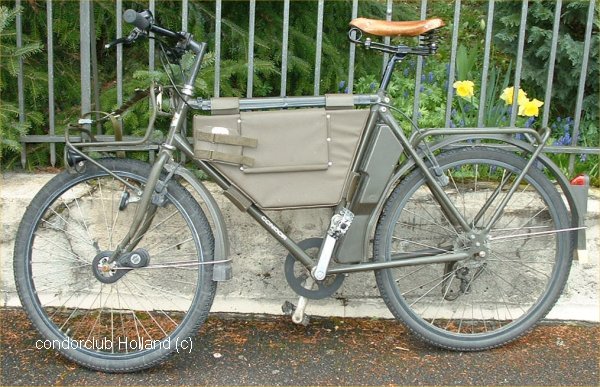
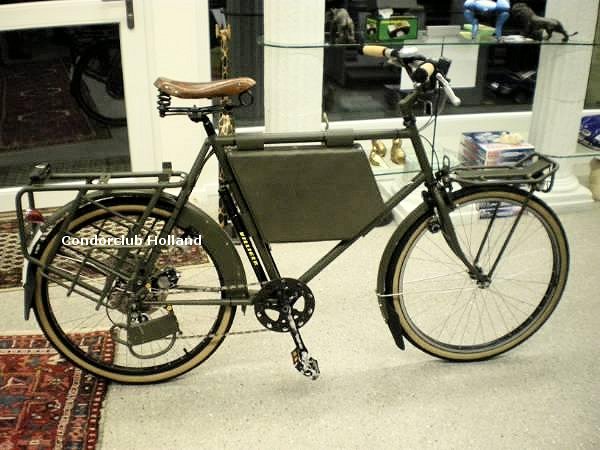 The
Swiss bicyclcle Factory VILLIGER produced a prototype for the new militairy
bicycle. Some parts and design details are used for the Condor bike.
The
Swiss bicyclcle Factory VILLIGER produced a prototype for the new militairy
bicycle. Some parts and design details are used for the Condor bike.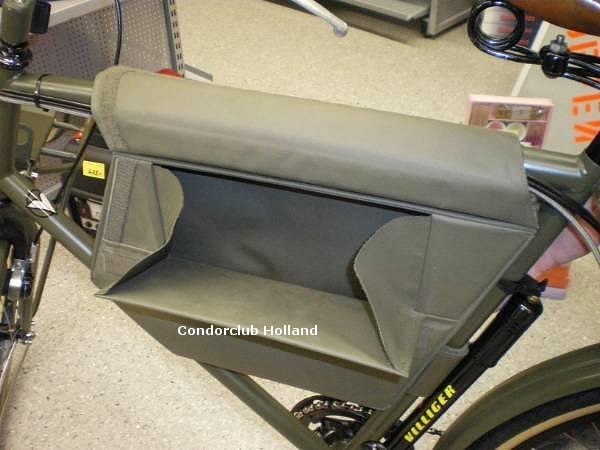 Also
the framebag is another design and did not make the productionline
Also
the framebag is another design and did not make the productionline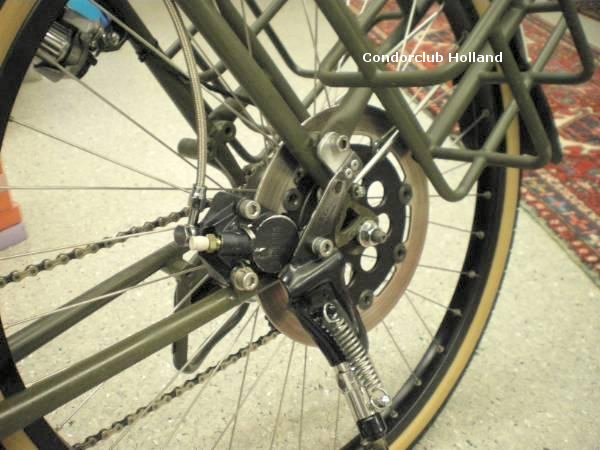 No,
a disk brake was not used on the final bike.
No,
a disk brake was not used on the final bike.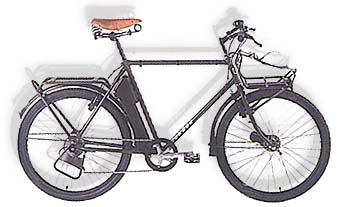

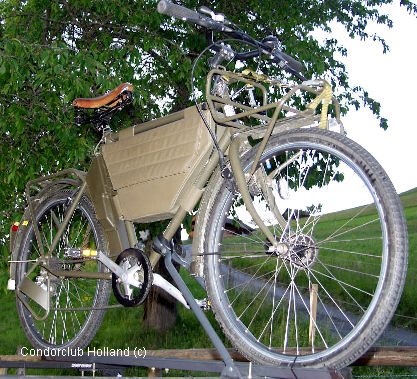
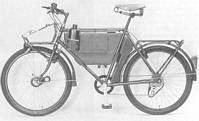











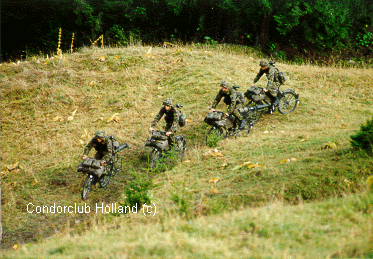 The famous green-camouflaged
Swiss army bicycles, like the knives, are the stuff of legend. Introduced
in 1891 despite opposition from the cavalry, the bikes became an integral
part of the Swiss defence force. The modern seven-gear mountain bikes,
which Swiss Cycle Regiment recruits call their "metal mules", carry up
to 160 kilograms of equipment, including bazookas, mortars, grenades and
ammunition. The bikes can reach downhill speeds of almost 65kmh. The regiment's
role in a conflict is to fortify a flank and guard the valleys from Lake
Geneva to Lake Constance. The main advantage of the cyclists is that they
can be deployed rapidly. Soldiers in other countries might regard them
as something of a joke, but the Swiss are fiercely proud of their combat
cycling tradition. Even so, officers and recruits admit that their bikes
have no place in a modern high-tech army. "I've served 700 days on my bike,
but you have to be realistic. An army costs money and we can't hang on
to the bikes just for the sake of tradition," Captain Matthias Zavratnik,
28, said. He is "deeply saddened" that the regiment will soon be gone.
There was a public outcry when Switzerland phased out the mounted cavalry
in the 1970s and its carrier pigeon service in the 1990s. But the end of
the cycle regiment of 3000, scheduled for 2003, is seen as the cruellest
aspect of a sweeping modernisation of the armed forces. It is believed
to be the world's last combat cycle regiment. Captain Daniel Setz, one
of Switzerland's few career soldiers, lamented that the cyclists had to
go, but said: "I must provide my men with maximum protection. A platoon
of cyclists could be decimated by a modern fragmentation bomb and would
stand no chance against snipers." A 2800-member transport horse unit is
also marked to go as army numbers are cut from 360,000 to 100,000.
The famous green-camouflaged
Swiss army bicycles, like the knives, are the stuff of legend. Introduced
in 1891 despite opposition from the cavalry, the bikes became an integral
part of the Swiss defence force. The modern seven-gear mountain bikes,
which Swiss Cycle Regiment recruits call their "metal mules", carry up
to 160 kilograms of equipment, including bazookas, mortars, grenades and
ammunition. The bikes can reach downhill speeds of almost 65kmh. The regiment's
role in a conflict is to fortify a flank and guard the valleys from Lake
Geneva to Lake Constance. The main advantage of the cyclists is that they
can be deployed rapidly. Soldiers in other countries might regard them
as something of a joke, but the Swiss are fiercely proud of their combat
cycling tradition. Even so, officers and recruits admit that their bikes
have no place in a modern high-tech army. "I've served 700 days on my bike,
but you have to be realistic. An army costs money and we can't hang on
to the bikes just for the sake of tradition," Captain Matthias Zavratnik,
28, said. He is "deeply saddened" that the regiment will soon be gone.
There was a public outcry when Switzerland phased out the mounted cavalry
in the 1970s and its carrier pigeon service in the 1990s. But the end of
the cycle regiment of 3000, scheduled for 2003, is seen as the cruellest
aspect of a sweeping modernisation of the armed forces. It is believed
to be the world's last combat cycle regiment. Captain Daniel Setz, one
of Switzerland's few career soldiers, lamented that the cyclists had to
go, but said: "I must provide my men with maximum protection. A platoon
of cyclists could be decimated by a modern fragmentation bomb and would
stand no chance against snipers." A 2800-member transport horse unit is
also marked to go as army numbers are cut from 360,000 to 100,000.
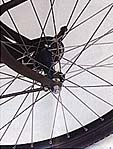
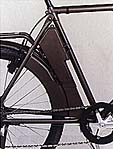
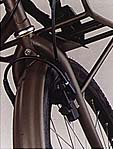
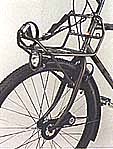
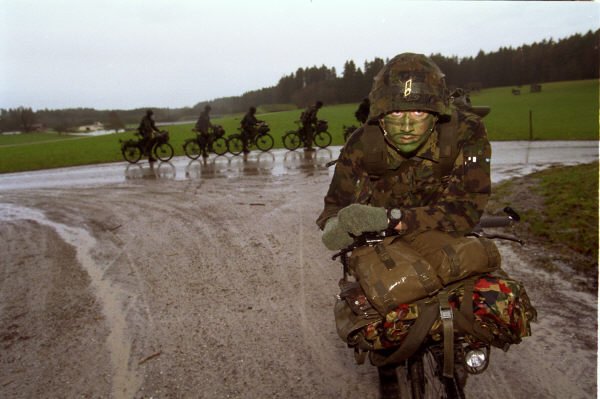
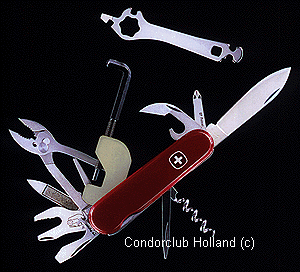
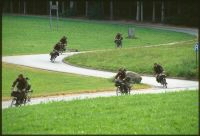 A proud and unique part of
the Alpine nation's sturdy defenses, the Swiss army bicycle brigade
is set to follow the mounted cavalry and carrier pigeon service into history.
The abolition of the world's last remaining combat cyclist regiment along
with a 2,800-strong transport horse unit - is part of sweeping Defense
Ministry reforms to modernize and rationalize Switzerland's militia army.
"There's no more room for the cyclists. They're not protected enough,"
bemoans Col. Jean-Pierre Leuenberger, one of the commanders of the 3,000
men. "Can you imagine a Swiss cyclist unit in the Gulf War?" ,"At the professional
level, I accept that we have to modernize our army to keep up with our
neighbors. But sentimentally, I'm sorry," Leuenberger said, watching his
recruits slice through torrential rain up a dauntingly steep hill. The
cyclists were introduced in 1891 against considerable opposition from the
cavalry. They eventually became a backbone of the Swiss defense force because
they were swifter and more discreet than infantry and motorized units.
A proud and unique part of
the Alpine nation's sturdy defenses, the Swiss army bicycle brigade
is set to follow the mounted cavalry and carrier pigeon service into history.
The abolition of the world's last remaining combat cyclist regiment along
with a 2,800-strong transport horse unit - is part of sweeping Defense
Ministry reforms to modernize and rationalize Switzerland's militia army.
"There's no more room for the cyclists. They're not protected enough,"
bemoans Col. Jean-Pierre Leuenberger, one of the commanders of the 3,000
men. "Can you imagine a Swiss cyclist unit in the Gulf War?" ,"At the professional
level, I accept that we have to modernize our army to keep up with our
neighbors. But sentimentally, I'm sorry," Leuenberger said, watching his
recruits slice through torrential rain up a dauntingly steep hill. The
cyclists were introduced in 1891 against considerable opposition from the
cavalry. They eventually became a backbone of the Swiss defense force because
they were swifter and more discreet than infantry and motorized units. 